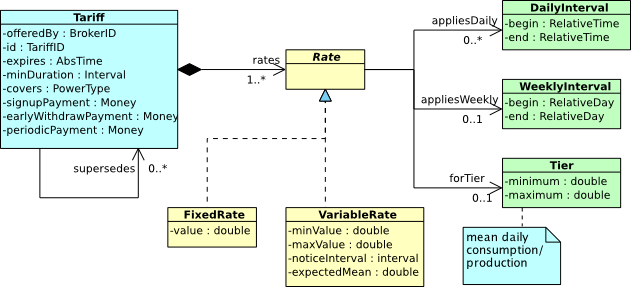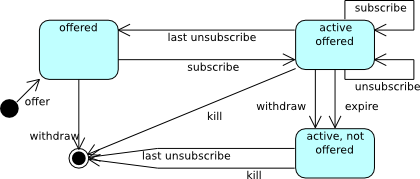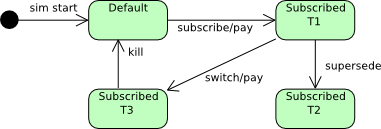Difference between revisions of "Tariff Market"
Grampajohn (talk | contribs) |
Grampajohn (talk | contribs) |
||
| Line 31: | Line 31: | ||
== Tariff and Subscription lifecycles == | == Tariff and Subscription lifecycles == | ||
| − | [[Image:Tariff-states.png|frame|Tariff | + | [[Image:Tariff-states.png|frame|Tariff state transitions]]Tariffs may be offered by Brokers at any time, and Customers may subscribe to offered Tariffs at any time. When a Tariff is first offered, it has no subscribers. Until it has at least one subscription, the Broker may withdraw it at any time. |
Once a Customer subscribes to a Tariff, it becomes active, and continues to be offered for new subscribers. Tariffs may have an expiration date; once that date passes, existing subscriptions continue, but new subscriptions are not allowed. Once the last subscription is removed, the Tariff is no longer in the market. | Once a Customer subscribes to a Tariff, it becomes active, and continues to be offered for new subscribers. Tariffs may have an expiration date; once that date passes, existing subscriptions continue, but new subscriptions are not allowed. Once the last subscription is removed, the Tariff is no longer in the market. | ||
| Line 37: | Line 37: | ||
A broker can withdraw a Tariff that has no subscriptions. Once a tariff has subscriptions, withdrawing a tariff has the effect of not allowing new subscriptions. A tariff with subscriptions may be forcefully withdrawn or ''killed'', in which case existing subscriptions are transferred to the succeeding Tariff. Presumably the Broker will have offered a new Tariff that 'supersedes' the withdrawn tariff first. If not, then subscriptions will revert to the initial default tariff. | A broker can withdraw a Tariff that has no subscriptions. Once a tariff has subscriptions, withdrawing a tariff has the effect of not allowing new subscriptions. A tariff with subscriptions may be forcefully withdrawn or ''killed'', in which case existing subscriptions are transferred to the succeeding Tariff. Presumably the Broker will have offered a new Tariff that 'supersedes' the withdrawn tariff first. If not, then subscriptions will revert to the initial default tariff. | ||
| − | [[Image:Subscription-states.png|frame | + | [[Image:Subscription-states.png|frame]]Each Customer has a current subscription at all times. At the beginning of the simulation, all Customers are subscribed to a default tariff with a non-player Incumbent broker (presumably the regulated monopoly). When a Customer subscribes to a Tariff ''T1'', it pays the subscription fee (which is probably negative, making it a sign-up bonus), and begins operating under the terms of ''T1''. If the Broker decides to supersede ''T1'' with a new Tariff ''T2'', then the Customer's subscription is changed to Tariff ''T2'', except that the early-withdrawal penalty of ''T2''is waived for this subscription. In other words, if a Broker switches a Customer's subscription, the Customer can switch Brokers without penalty. If a Customer decides to switch its subscription from Tariff ''T1'' to another Tariff ''T3'', then its subscription is switched, after paying any early-withdrawal penalty due under the terms of ''T1''. |
== Customer population models == | == Customer population models == | ||
Revision as of 03:07, 11 December 2010
Contents
Tariff Market
Brokers acquire customers by offering tariff contracts. Customers are always under contract with some tariff. They will evaluate the available tariffs with respect to their own preferences, and may subscribe to one of the offered tariffs subject to the relative attractiveness compared with their current tariffs, and subject to an inertia factor that represents their general lack of attention to incoming junk mail.
Tariff representation
A Tariff is a structure composed of Rates, with applicability rules, as shown here.
This structure allows a number of features within a simple, compact object graph. The general convention is that missing elements simply do not apply. For example, a Rate without an attached Tier applies for all usage, and a Rate without any attached Daily or Weekly Intervals applies at all times. Here are some examples of tariff features that can be represented:
- Tiered rates, in which customers pay/receive one rate for a portion of usage (up to 20 kWh/day, for example), and a different rate (or set of rates) for the remainder. For example, a fixed rate could apply for the first 20 kWh/day, and another fixed rate could apply above that level on weekends, while a variable rate could apply on weekdays for the excess usage.
- Time-of-use rates would have a set of fixed rates for different intervals. The simplest form would be a night rate from perhaps 20:00 through 7:00, and a daytime rate from 7:00 through 20:00.
- Separate weekday and weekend rates.
- Two-part tariffs (fixed daily fee plus usage fee). The fixed fee is represented as the "periodicPayment" in the Tariff.
- Signup payments in either direction (fee or bonus), represented as positive or negative signupPayment values.
- Early withdrawal penalties.
- Variable rates with minimum and maximum values, estimated mean values, and notice intervals. The noticeInterval field in the variable rate is the minimum delay between a broker announcing a price change and the price change taking effect. So a noticeInterval of 2 hours would give customers at least a 2-hour notice of a price change. More specifically, for a rate with a 2-hour notice interval, the price change would take effect at the beginning of the third timeslot following the price-change announcement.
This structure does not allow a feature found in some real-world tariff examples: "Sign-up for a 6-month contract and you get the first month free," or "get 30% off for the first two months" or some other time limited rate specification."
A tariff applies to only one "Power Type" for a Customer. Power Type is a type of power consumption or production that is separately metered. Primary power types are
- Consumption: ordinary power consumption, not remotely interruptible. Customers may, of course, adapt to price variations (time-of-use or variable rates, for example) by shifting their usage with respect to their "baseline" consumption profiles.
- Interruptible consumption: power consumption that can be remotely interrupted. Typically this type of usage is connected to energy storage devices, such as water heaters or heat pumps, or even batteries. Brokers presumably induce Customers to allow interruption of their air conditioning systems by offering lower rates than they pay for ordinary consumption.
- Energy production: devices that produce power under certain conditions. Specific types of production supported in the simulation include:
- Solar panels: have a nominal capacity, which is the output at noon under a clear sky. The simulation models day-length and cloud cover, but not changing insolation angle.
- Wind turbines: have a nominal capacity, the output when the wind is blowing at 40 km/hr.
- Combined heat and power: or CHP systems are gas turbines that produce both power and heat. They produce power when the customer needs heat, and so their output is sensitive to the current temperature.
- Electric vehicle: charging/discharging of electric vehicles.
Tariff and Subscription lifecycles
Tariffs may be offered by Brokers at any time, and Customers may subscribe to offered Tariffs at any time. When a Tariff is first offered, it has no subscribers. Until it has at least one subscription, the Broker may withdraw it at any time.
Once a Customer subscribes to a Tariff, it becomes active, and continues to be offered for new subscribers. Tariffs may have an expiration date; once that date passes, existing subscriptions continue, but new subscriptions are not allowed. Once the last subscription is removed, the Tariff is no longer in the market.
A broker can withdraw a Tariff that has no subscriptions. Once a tariff has subscriptions, withdrawing a tariff has the effect of not allowing new subscriptions. A tariff with subscriptions may be forcefully withdrawn or killed, in which case existing subscriptions are transferred to the succeeding Tariff. Presumably the Broker will have offered a new Tariff that 'supersedes' the withdrawn tariff first. If not, then subscriptions will revert to the initial default tariff.
Each Customer has a current subscription at all times. At the beginning of the simulation, all Customers are subscribed to a default tariff with a non-player Incumbent broker (presumably the regulated monopoly). When a Customer subscribes to a Tariff T1, it pays the subscription fee (which is probably negative, making it a sign-up bonus), and begins operating under the terms of T1. If the Broker decides to supersede T1 with a new Tariff T2, then the Customer's subscription is changed to Tariff T2, except that the early-withdrawal penalty of T2is waived for this subscription. In other words, if a Broker switches a Customer's subscription, the Customer can switch Brokers without penalty. If a Customer decides to switch its subscription from Tariff T1 to another Tariff T3, then its subscription is switched, after paying any early-withdrawal penalty due under the terms of T1.
Customer population models
Individual customer models
Initial state of the market


